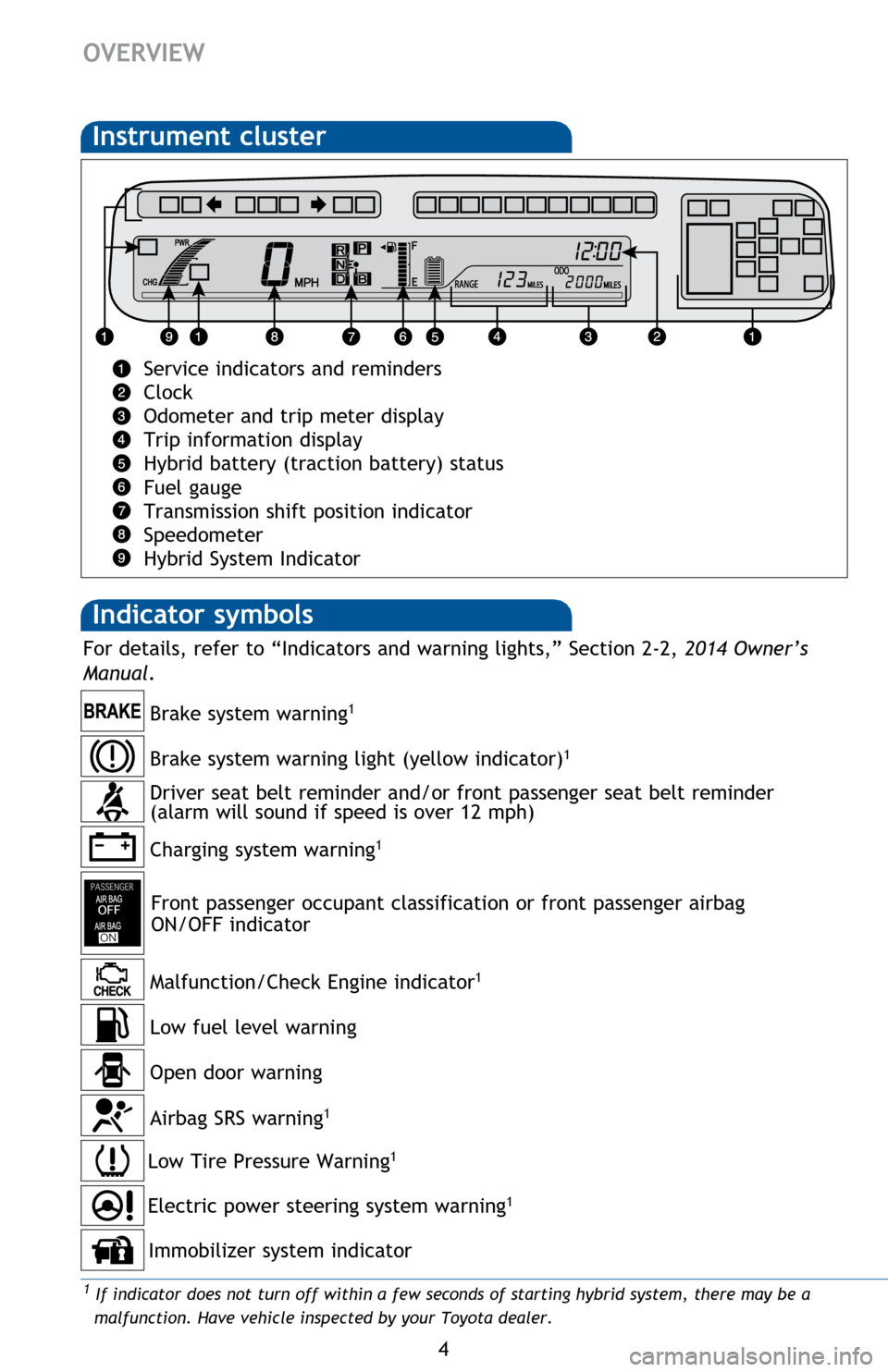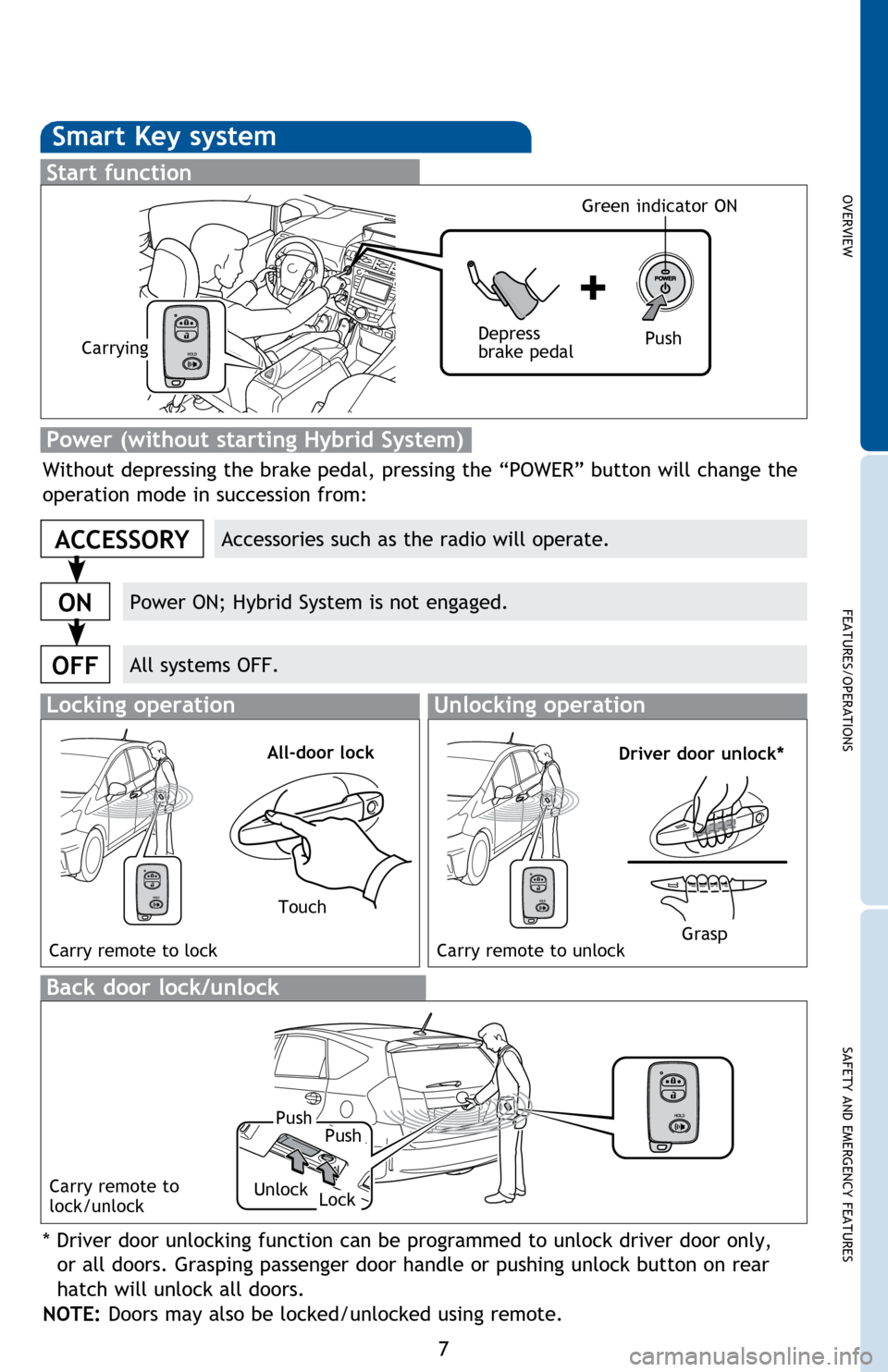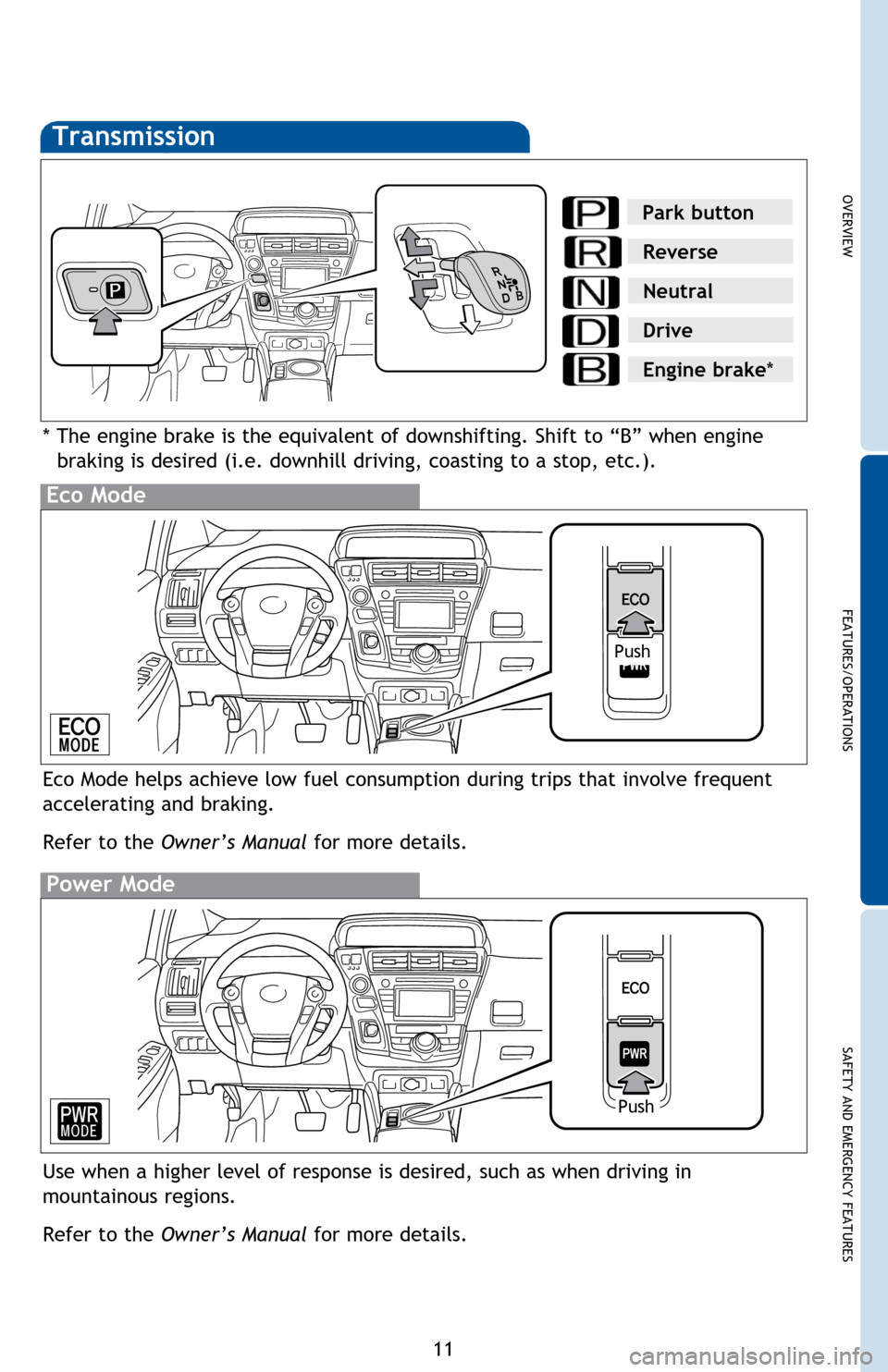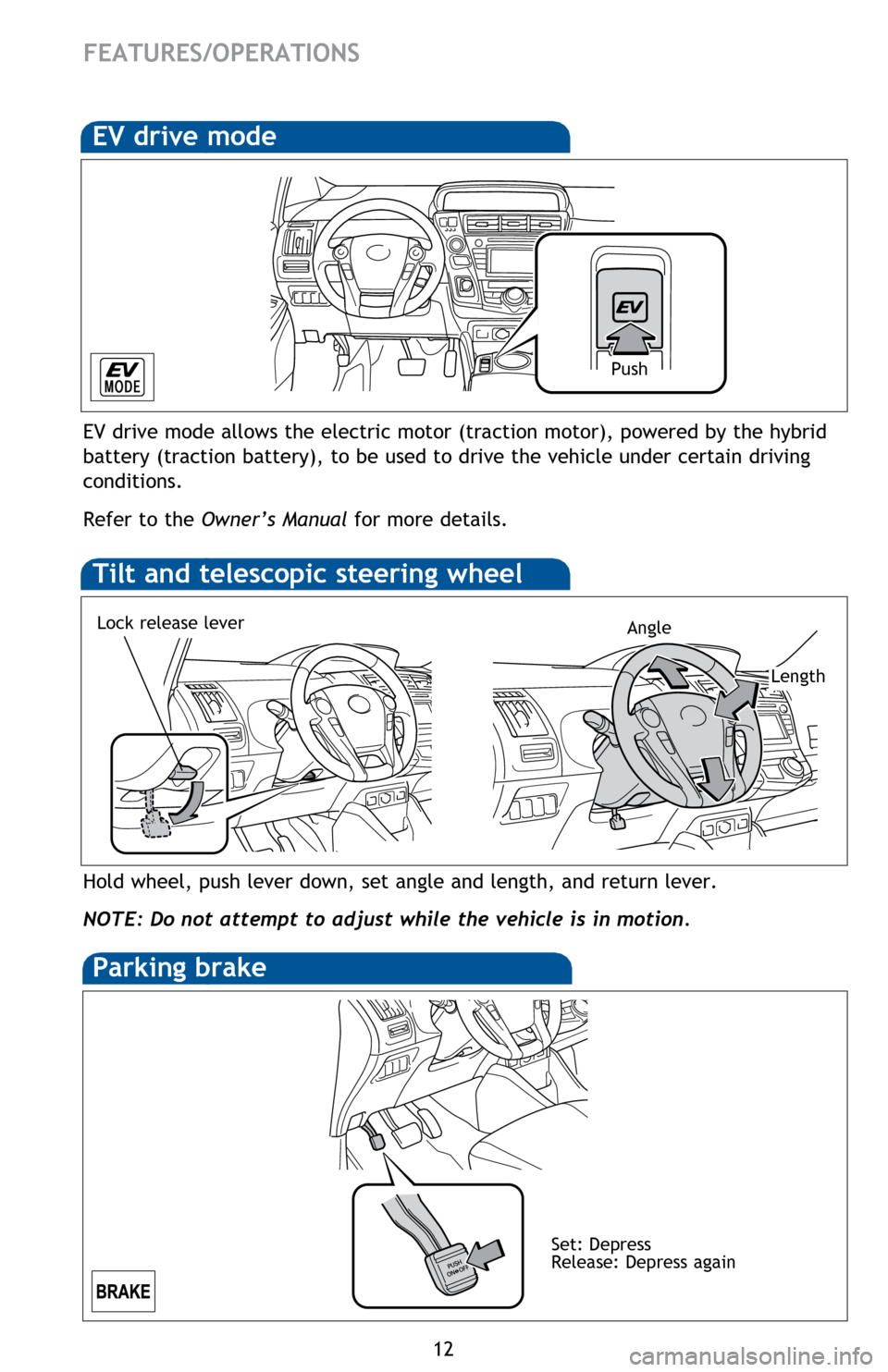brake TOYOTA PRIUS V 2014 ZVW40 / 1.G Quick Reference Guide
[x] Cancel search | Manufacturer: TOYOTA, Model Year: 2014, Model line: PRIUS V, Model: TOYOTA PRIUS V 2014 ZVW40 / 1.GPages: 32, PDF Size: 9.36 MB
Page 3 of 32

OVERVIEW
FEATURES/OPERATIONS
SAFETY AND EMERGENCY FEATURES
1
INDEX
OVERVIEW
FEATURES/OPERATIONS
SAFETY AND
EMERGENCY FEATURES
Engine maintenance 9
Fuel tank door release and cap 8
Hood release 8
Indicator symbols 4-5
Instrument cluster 4
Instrument panel 2-3
Keyless entry
1,2 6
Light control-Instrument panel 9
Smart Key system
1,2 7
Air Conditioning/Heating 17
Audio 18-19
Auto lock/unlock
1,2 10
Clock 23
Cruise control 20
Dynamic Radar Cruise Control 21
EV drive mode 12
Garage door opener (HomeLink
®)3 23
Hill-start Assist Control (HAC) 23
Hybrid Synergy Drive System 10
Lights1 & turn signals 15
Panoramic roof shades1 19
Parking brake 12
Power outlets 20
Seat adjustments-Front 13
Seat heaters 16
Seat-Folding down rear seat 14
Seats-Flattening front seatbacks 13
Seats-Head restraints 13
Steering wheel switches 19
Telephone controls (Bluetooth
®) 22
Tilt and telescopic steering wheel 12
Transmission 11
Trip information display 22
Windows-Power 16
Windshield wipers & washers 14
Doors-Child safety locks 25
Door locks 25
Floor mat installation 27
Seat belts 24
Seat belts-Shoulder belt anchor 24
Spare tire & tools 25
Star Safety System
TM 26-27
Tire Pressure Monitoring (warning) System 24
1 Visit your Toyota dealer for information on customizing this feature.2 Programmable by customer. Refer to the Owner’s Manual for instructions and
more information.
3 HomeLink® is a registered trademark of Johnson Controls, Inc.
Page 6 of 32

4
OVERVIEW
Indicator symbols
Instrument cluster
Service indicators and reminders
Clock
Odometer and trip meter display
Trip information display
Hybrid battery (traction battery) status
Fuel gauge
Transmission shift position indicator
Speedometer
Hybrid System Indicator
Charging system warning1
Brake system warning1
Front passenger occupant classification or front passenger airbag
ON/OFF indicator
Low Tire Pressure Warning1
Open door warning
Airbag SRS warning1
Driver seat belt reminder and/or front passenger seat belt reminder
(alarm will sound if speed is over 12 mph)
Malfunction/Check Engine indicator
1
Low fuel level warning
Electric power steering system warning1
Brake system warning light (yellow indicator)1
1
If indicator does not turn off within a few seconds of starting hybrid system, there may be a
malfunction. Have vehicle inspected by your Toyota dealer.
For details, refer to “Indicators and warning lights,” Section 2-2, 2014 Owner’s
Manual .
Immobilizer system indicator
Page 7 of 32

OVERVIEW
FEATURES/OPERATIONS
SAFETY AND EMERGENCY FEATURES
5
2 If this light flashes, refer to “Cruise control,” or “Dynamic radar cruise control,” Section 2-4, 2014 Owner’s Manual.
Anti-lock Brake System warning1
Headlight low/high beam indicators
Turn signal indicator
Slip indicator/Hill-start Assist Control indicator
1
READY indicator
Front fog light indicator
ECO MODE indicator
EV drive mode indicator
Automatic headlight leveling system warning
1
Cruise control indicators2
Pre-Collision System warning light1
High coolant temperature warning light1
Power Mode indicator
EV indicator
ECO Driving Indicator Light1
Low engine oil pressure warning1
Maintenance required reminder1
Hybrid System warning1
Smart Key system warning
Hybrid System overheat warning1
P position request indicator1
Low Hybrid battery (traction battery) warning
LED headlight warning1
Parking lock system warning1
Parking lock system warning message
Page 9 of 32

OVERVIEW
FEATURES/OPERATIONS
SAFETY AND EMERGENCY FEATURES
7
Smart Key system
Start function
Accessories such as the radio will operate.
Power ON; Hybrid System is not engaged.
All systems OFF.
ACCESSORY
ON
OFF
Push
Depress
brake pedalCarrying Green indicator ON
Without depressing the brake pedal, pressing the “POWER” button will change the
operation mode in succession from:
Power (without starting Hybrid System)
* Driver door unlocking function can be programmed to unlock driver door only,
or all doors. Grasping passenger door handle or pushing unlock button on rear
hatch will unlock all doors.
NOTE: Doors may also be locked/unlocked using remote.
Locking operationUnlocking operation
Carry remote to lock Carry remote to unlock
All-door lockDriver door unlock*
Back door lock/unlock
Carry remote to
lock/unlock
Touch
Grasp
Push
Lock
Push
Unlock
Page 12 of 32

10
FEATURES/OPERATIONS
Starting your vehicle
The Hybrid Synergy Drive System utilizes a computer-controlled gasoline engine
and electric motor to provide the most efficient combination of power for the
vehicle. To conserve energy, when the brakes are applied the braking force
generates electricity which is then sent to the traction battery. In addition,
the engine shuts off when the vehicle is stopped. The benefits are better fuel
economy, reduced vehicle emissions and improved performance.
NOTE: Fuel consumption and energy information of the Hybrid System are shown on the Display Audio system screen or the navigation system
screen.
Tips for improved fuel economy
-Ensure tire pressures are maintained at levels specified in the Owner’s Manual.
-When possible, link trips to reduce engine cold starts.
-Avoid driving at speeds that are higher than necessary, especially on the highway.
-When possible, avoid sudden stops to maximize regenerative braking energy.
-Minimize use of the Air Conditioning.
Hybrid Synergy Drive System
Auto lock/unlock
Automatic door locks can be programmed to operate in two different modes, or
turned OFF.
-Doors lock when shifting from Park.
-Doors lock when the vehicle speed is approximately 12 mph or higher.
-Doors unlock when shifting into Park.
-Doors unlock when the driver’s door is opened within 10 seconds after turning the
“POWER” switch OFF.
Refer to the Owner’s Manual for more details.
(1) Depress the brake pedal, and
press the “POWER” switch
briefly and firmly.
(2) The “READY” light will blink. After a few seconds, when the
light remains steady and a beep
sounds, you may begin driving.
Page 13 of 32

OVERVIEW
FEATURES/OPERATIONS
SAFETY AND EMERGENCY FEATURES
11
Transmission
* The engine brake is the equivalent of downshifting. Shift to “B” when engine braking is desired (i.e. downhill driving, coasting to a stop, etc.).
Eco Mode
Push
Eco Mode helps achieve low fuel consumption during trips that involve frequent
accelerating and braking.
Refer to the Owner’s Manual for more details.
Park button
Reverse
Neutral
Drive
Engine brake*
Power Mode
Use when a higher level of response is desired, such as when driving in
mountainous regions.
Refer to the Owner’s Manual for more details.
Push
Page 14 of 32

12
FEATURES/OPERATIONS
Hold wheel, push lever down, set angle and length, and return lever.
NOTE: Do not attempt to adjust while the vehicle is in motion.
Tilt and telescopic steering wheel
EV drive mode
EV drive mode allows the electric motor (traction motor), powered by the hybrid
battery (traction battery), to be used to drive the vehicle under certain driving
conditions.
Refer to the Owner’s Manual for more details.
Push
Angle
Length
Lock release lever
Parking brake
Set: Depress
Release: Depress again
Page 22 of 32

20
Cruise control (if equipped)
1 The set speed may also be cancelled by depressing the brake pedal.2 The set speed may be resumed once vehicle speed exceeds 25 mph.
Turning system ON/OFF
Functions
System ON/OFF
Increase speed
Decrease speed
Cancel
1
Resume2
Set
FEATURES/OPERATIONS
Power outlets
Center console
Luggage compartment (if equipped)
Power switch must be set at “ACCESSORY” or “ON” mode to be used.
Page 25 of 32

OVERVIEW
FEATURES/OPERATIONS
SAFETY AND EMERGENCY FEATURES
23
Clock
Refer to the Owner’s Manual for details on adjusting time.
H- Hour set
M- Minute set
:00- Round off
minutes
HAC helps prevent rolling backwards on an incline. To engage, push further down
on brake pedal while at a complete stop until a beep sounds and slip indicator
illuminates. HAC holds for approximately two seconds after releasing brake pedal.
Refer to the Owner’s Manual for more details.
Brake
pedal
Hill-start Assist Control (HAC)
Garage door openers manufactured under license from HomeLink®* can be
programmed to operate garage doors, estate gates, security lighting, etc\
.
Refer to “Garage door opener,” Section 3-5 in the Owner’s Manual for more
details.
For programming assistance, contact HomeLink
® at 1-800-355-3515, or visit
http://www.homelink.com.
* HomeLink® is a registered trademark of Johnson Controls, Inc.
Garage door opener (HomeLink®)*
(if equipped)
Page 28 of 32

26
SAFETY AND EMERGENCY FEATURES
Star Safety SystemTM
Enhanced Vehicle Stability Control provides cooperative control of the ABS, TRAC,
VSC and EPS.
Enhanced VSC helps to maintain directional stability when loss of traction occurs
during a turn.
Enhanced Vehicle Stability Control (VSC)
Anti-Lock Brake System (ABS)
ABS helps prevent brakes from locking up by “pulsing” brake pressure to each
wheel. This limits brake lockup and helps provide directional control for the
current road conditions.
Toyota’s ABS sensors detect which wheels are locking up and limits wheel lockup
by “pulsing” each wheel’s brakes independently. Pulsing releases brake pressure
repeatedly for fractions of a second. This helps the tires attain the traction that
current road conditions will allow, helping you to stay in directional control.
Brake Assist (BA)
Brake Assist is designed to detect sudden or “panic” braking, and then add braking
pressure to help decrease the vehicle’s stopping distance. When there’s only a
split second to react, Brake Assist can add additional brake pressure more quickly
than just the driver alone can. VSC helps prevent loss of traction during cornering by reducing Hybrid System
output, and Traction Control helps maintain traction on loose gravel and wet, icy,
or uneven surfaces by applying brake force to the spinning wheel(s).
Toyota’s TRAC sensors are activated when one of the drive wheels starts to slip.
TRAC limits Hybrid System output and applies the brakes to the spinning wheel.
This transfers power to the wheels that still have traction to help keep you on
track.
Traction Control (TRAC)
Electronic Brake Force Distribution (EBD)
Toyota’s ABS technology has Electronic Brake-force Distribution (EBD) to help
maintain control and balance when braking. Abrupt stops can cause a vehicle
to tilt forward, reducing the braking power of the rear wheels. EBD responds to
sudden stops by redistributing brake force to enhance the braking effectiveness of
all four wheels. All new Toyota vehicles come standard with the Star Safety System
TM, which
combines Vehicle Stability Control (VSC), Traction Control (TRAC), Anti-lock Braking
System (ABS), Electronic Brake-force Distribution (EBD), Brake Assist (BA) and Smart
Stop Technology (SST).